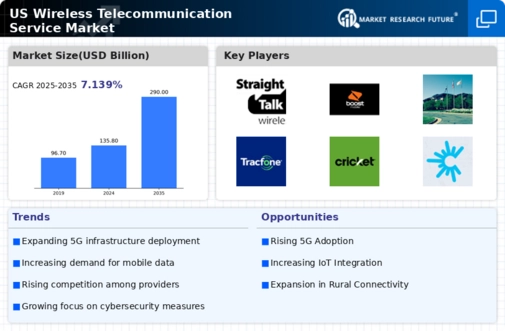The US Wireless Telecommunication Service Market is characterized by intense competition among key players striving to carve out market share while catering to an increasingly tech-savvy and mobile-centric consumer base. Companies are leveraging innovations in technology and changes in consumer preferences to enhance their offerings and service delivery. The market dynamics are influenced heavily by advancements in wireless technology, regulatory changes, and evolving customer expectations for seamless connectivity and high-speed data access. As businesses race to implement 5G technology, they are focused on expanding network coverage, improving service quality, and addressing the demands of both individual consumers and enterprise clients.
The ability to adapt to these rapidly changing conditions while maintaining customer loyalty plays a pivotal role in determining success within the market.MetroPCS stands out in the US Wireless Telecommunication Service Market primarily through its strategic focus on affordability and straightforward plan structures that attract budget-conscious consumers. Its strengths lie in its no-contract policy, appealing plans, and competitive pricing, which enhance customer accessibility to wireless services. MetroPCS positions itself well as a provider of unlimited talk, text, and data services, allowing it to appeal to a wide array of consumers including students, families, and individuals seeking flexibility.
The brand thrives in urban areas, leveraging its cost-effective service model while maintaining a significant retail presence to improve customer engagement through strong brand loyalty. This approach has enabled MetroPCS to secure a considerable chunk of the prepaid segment of the market, contributing to its overall growth
.Sprint Corporation has been a formidable contender in the US Wireless Telecommunication Service Market, recognized for its diverse range of mobile and other telecommunication services tailored for various customer segments.
The company offers a broad array of products, including postpaid and prepaid plans, mobile broadband, and ancillary services, which cater to both individual consumers and businesses. Sprint's strengths lie in its network advancements geared towards 5G deployment and strategic partnerships that enhance service offerings. In recent years, Sprint has engaged in mergers and acquisitions to consolidate its market position, which includes notable partnerships aimed at broadening its technology capabilities and improving operational efficiencies.
With focused initiatives on customer service and competitive pricing strategies, Sprint has worked to redefine its market presence, contributing to its resilience and ability to adapt in a rapidly evolving sector.








Leave a Comment